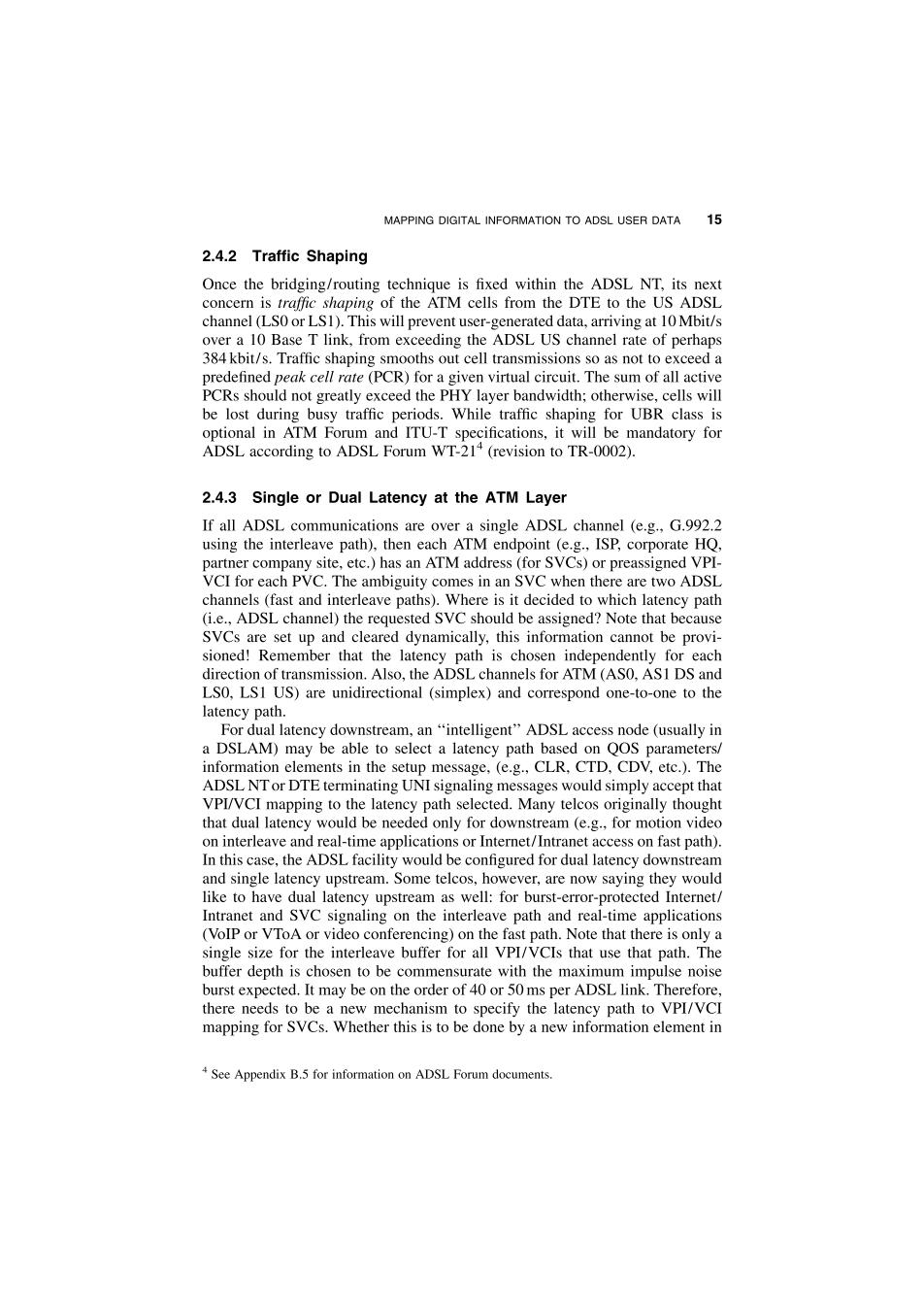正在加载图片...

MAPPING DIGITAL INFORMATION TO ADSL USER DATA 5 2.4.2 Traffic Shaping Once the bridging/routing technique is fixed within the ADSL NT,its next concern is traffic shaping of the ATM cells from the DTE to the US ADSL channel(LSO or LS1).This will prevent user-generated data,arriving at 10 Mbit/s over a 10 Base T link,from exceeding the ADSL US channel rate of perhaps 384 kbit/s.Traffic shaping smooths out cell transmissions so as not to exceed a predefined peak cell rate (PCR)for a given virtual circuit.The sum of all active PCRs should not greatly exceed the PHY layer bandwidth;otherwise,cells will be lost during busy traffic periods.While traffic shaping for UBR class is optional in ATM Forum and ITU-T specifications,it will be mandatory for ADSL according to ADSL Forum WT-214(revision to TR-0002). 2.4.3 Single or Dual Latency at the ATM Layer If all ADSL communications are over a single ADSL channel (e.g.,G.992.2 using the interleave path),then each ATM endpoint (e.g.,ISP,corporate HQ, partner company site,etc.)has an ATM address(for SVCs)or preassigned VPI- VCI for each PVC.The ambiguity comes in an SVC when there are two ADSL channels(fast and interleave paths).Where is it decided to which latency path (i.e.,ADSL channel)the requested SVC should be assigned?Note that because SVCs are set up and cleared dynamically,this information cannot be provi- sioned!Remember that the latency path is chosen independently for each direction of transmission.Also,the ADSL channels for ATM(AS0,AS1 DS and LSO,LSI US)are unidirectional (simplex)and correspond one-to-one to the latency path. For dual latency downstream,an "intelligent"ADSL access node (usually in a DSLAM)may be able to select a latency path based on QOS parameters/ information elements in the setup message,(e.g.,CLR,CTD,CDV,etc.).The ADSL NTor DTE terminating UNI signaling messages would simply accept that VPI/VCI mapping to the latency path selected.Many telcos originally thought that dual latency would be needed only for downstream (e.g.,for motion video on interleave and real-time applications or Internet/Intranet access on fast path). In this case,the ADSL facility would be configured for dual latency downstream and single latency upstream.Some telcos,however,are now saying they would like to have dual latency upstream as well:for burst-error-protected Internet/ Intranet and SVC signaling on the interleave path and real-time applications (VoIP or VToA or video conferencing)on the fast path.Note that there is only a single size for the interleave buffer for all VPl/VCIs that use that path.The buffer depth is chosen to be commensurate with the maximum impulse noise burst expected.It may be on the order of 40 or 50ms per ADSL link.Therefore, there needs to be a new mechanism to specify the latency path to VPI/VCI mapping for SVCs.Whether this is to be done by a new information element in 4 See Appendix B.5 for information on ADSL Forum documents.
!"#$%&'() !
*+,-./01,2345
6#(7 88 6
9 $(:
;%#$%& <8=&%>
&%?@A( "88BC
D<<<)<C<?>7
C<?>E< (8F)6
9!#$%&;%<8<
6B<B GHIF A(<6 <B 9
88< 9
<
!< B 2J,K/JLL+,*J=MNO@6
<CC
<8
A(
9
6<88<C MNO
8
<8P!MQR8<P<"S
" )88 "88 8
P<6 B
AT8<6 <B6
;EO8<
B
<8#(7 U
9 <V(;D( B <
)"889<<
P6
#$%&<
#$%&U
9T(DW?I=C
(OD>>>W@A X YZ[\]Y^_Z `__
Zab ^`Z V6<88#$%&
99
<
<
C< 8#$%&<8=AA)cAddWAW
8<CB<@)<#(7 B
=AA)V%M)
B
<Qe) B<
9B<P )A@< <#(7< =6
%fN @
B< fMVD fNV6
<MfNA(<9
P
9 <%fN"<"
#$%& <8 =6< <8<CB< @AT
"8<PB< =AA)#$%&<8@
%fN
8< g'
<<
%fN <
B<8<P<9<88P) 6
9<
<
B
CD
hO99<8<PB<
B8P6
<
6< 9
A#8
)#$%&<8 6
#(7=#%>)#%?$%< &%>)&%?;%@<
<8= 9B8!@<
B
D
D
8<PB<A U
<88<P
" <9)<ii88jj#$%&<
=
<88P <$%@9<P<8
8<8<PB<<
e%B<<9 6
9<
89
B9 <)=AA)N&O)N($)N$f)A@A( #$%&'(
$(:9<;'V <89 < "
8 9B8P<B< fMVfNV9<BB
8<PB< 8A7<P8
<88P
<
<88<P"
8
8P6
" <9=AA)6
9
C
8<C<<8D9<BB8<
VV<<
6< B<@A V < )#$%&6<8P"
8
6
<88<P
" <9 < 88<P
B <9A%
98
)
"C)<
" <PP"
8 8F
<C
<88<P
B <9< "88k6
D
DB
V V<<%fN <8
8<CB<<<8D9<BB8<
=f
VM
f(
#
C
6@
6< B<A'
<
8P< 8 l6
8<C
666
<88fMVfNV <
<B<A(
66B
99
<"9<!9
99B
8
!BAV9<P
6I>
m>9 B#$%&8FA(6
)
<"9< 9
B6P8<PB<
fMVfNV 9<BB6
%fN AT
P<"6
9<
89 I%#BB!EAm6
6
9<
#$%&U
9
9 A noppqrs tqsquovqrwxynouqxrux otzv{z|ytouo }~������